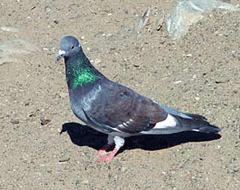Winged Rats or Wronged Warriors?
Air Date: Week of July 4, 2008

(Courtesy of National Parks Service)
Living on Earth drops in on pigeons, for a change. Author Andrew Blechman joins host Bruce Gellerman to discuss why this once-lauded war hero has been pigeon-holed as a public enemy.
Transcript
GELLERMAN: Here’s the poop on pigeons: some people consider them dirty, disease-carrying pests, a real public nuisance. And then there are those people with a passion for pigeons - a person like Andrew Blechman, for example. He’s written a book about the bird titled “Pigeons: The Fascinating Saga of the World’s Most Revered and Reviled Bird” and he joins me. Thank you very much, Andrew.
BLECHMAN: Good to be here.
GELLERMAN: It really is a fascinating saga. Who would have thought that the pigeon had such an amazing history?
BLECHMAN: Well, certainly not me. I’ve tripped into this by accident and the more I learned about this bird the more I was amazed.
GELLERMAN: Well you could say it was a real accident.
BLECHMAN: Yeah, it was actually. I was at the bodega - I used to live in Manhattan - I was getting a tuna sandwich. This place made it just the way I liked it, and while I was there I met a guy named Jose and he tells me that he races pigeons and he got my attention. I didn’t know that people did that, let alone still did that. And he told me that his pigeons were thoroughbreds. That really caught my attention.
GELLERMAN: I know, like horses. They breed pigeons like they do race horses.
BLECHMAN: Absolutely, actually, in fact the very best pigeons they can bring in a pot of a million dollars at an international race. Actually they’re sold at auction for tens of thousands of dollars. And they’re studded out for several thousand dollars a go.
GELLERMAN: They’re related to doves.
BLECHMAN: Yeah, actually they are. They’re called the rock dove. In fact pigeon is just basically French for “dove.” Just like “paloma” is Spanish for pigeon or dove.
GELLERMAN: Do all pigeons home?
BLECHMAN: Yes, all rock doves do. Some do it better than others through practice, such as the homing pigeons, I mean they are thoroughbreds but they all do home. They used to be cliff dwellers. And let’s say that they were, think of the Cliffs of Dover. They would basically nest in the cliffs and then they would forage inland for food. And they would never abandon the nest. And when they mate they mate for life so they would always come back with their food. They basically honed that skill to find their way back.

Andrew Blechman is author of "Pigeons: The Fascinating Saga of the World's Most Revered and Reviled Bird" (Photo: Holy Rockwell)
BLECHMAN: You know it’s funny you should ask. I talked to the very top people in the field including a gentleman at Cornell who dedicated his life to this and no one’s entirely sure. But there are a lot of theories out there and they do have an idea how it does. But they actually are able to sense a magnetic field around the earth. They’re also able to know where they are using the sun, and the moon, and the stars basically. And the other thing is they have ultrasound hearing so they can gauge where they are. They can hear wind over the Rockies from 2,000 miles away, and gauge where they are by that as well.
GELLERMAN: Well they have extraordinary endurance and speed.
BLECHMAN: Yeah, they routinely will fly 600-mile races at more than 60 miles an hour.
GELLERMAN: You write about pigeons playing a role, an important role, in the Battle of Waterloo.
BLECHMAN: Actually, they play, I would almost say, a financial role. Baron Rothschild at the time he sent a currier with a pigeon to the battle so that the minute that Napoleon lost, the message was then flown to England by pigeon where he got the news a day early and of course he invested accordingly. At the time don’t forget, pigeons were the fastest way to get anything anywhere. They were basically FedEx or Airborne Express. Other than a pigeon all you had was a horse going at about a trot or a gallop.
GELLERMAN: They have an illustrious history. I didn’t realize there were more pigeons honored as heroes in World War One and Two than canines.
BLECHMAN: Yeah, when you look at a pigeon in the park you wouldn’t think that guy’s related to war heroes but they are. In fact, they’re decorated metal war heroes. One million pigeons served in World War One and Two and literally saved thousands of soldier’s lives.

(Courtesy of National Parks Service)
BLECHMAN: Yeah, they would ferry critical messages from one place back to headquarters. And they invariably made it back, and quickly. Now think about this too: the first Olympics in 776 BC, the news of the results of the winners was actually sent out to all of the villages by pigeons.
GELLERMAN: Charles Darwin, you write, didn’t get his inspiration for the theory of natural selection from finches, but from pigeons.
BLECHMAN: You know, it’s interesting. We always talk about the finches when we think of Darwin, but that was very early on. That’s when he first got some inklings of what was going on. But it was actually pigeons that he used. He was a pigeon fancier and he would breed them in his backyard.
GELLERMAN: So, you have so many people that love pigeons, but they get such a bad rap. You could say they were, and I’m going to make a bad joke, pigeon-holed.
BLECHMAN: Yeah, they are pigeonholed. And it’s a critical issue. This is an absolutely horribly persecuted bird. The put caustic gels on perches, which burn through its feet. It’s poisoned routinely, electrocuted. And it’s actually a phenomenal animal.
GELLERMAN: Well, Tom Lehrer once wrote about poisoning pigeons in the park with cyanide-coated peanuts.
BLECHMAN: Yeah, somewhere it became funny to persecute pigeons. I’m not really sure where that came. I was always told that to pick on someone smaller than you just wasn’t particularly cool.
GELLERMAN: Well, could it be Woody Allen in Stardust Memories, he called them what, rats...
BLECHMAN: Rats with wings, yeah. It’s believed he invented the phrase “rats with wings.” But they’re really not. In fact, they’re no dirtier than we are. They live off what we drop.
GELLERMAN: Well, what about what they drop? Isn’t that like, really bad for us?
BLECHMAN: No, it’s really no different than what we drop. The problem is that they don’t have toilets. And the problem really is that there’s too many of them. If we had fewer pigeons it wouldn’t be a bigger problem. But then again, you know, wildlife can be inconvenient.
GELLERMAN: Especially urban wildlife. They’re one of the last real vestiges of urban wildlife.
BLECHMAN: And that’s why we really need to appreciate them. I found, that when I lived in New York City, that they really animate the place.
GELLERMAN: So, Andrew, what is your suggestion? What do we do with pigeons to solve the problem?
BLECHMAN: You know humane pigeon control really isn’t that difficult. It’s very simple, really, and they do it all through Germany, Switzerland, and the BENOLUX countries, you know the Netherlands and Holland. And what you do is you create pigeon coops. They’re really just hen houses. And you put them in public areas. And they can be quite beautiful; you can have contests for designing them. And you ask people to feed the birds there and that’s were they will breed. And at the end of each week you just cultivate the eggs, you just remove the eggs. And you can reduce the pigeon population by half in a matter of a year or two. You know it’s interesting, for 10,000 years pigeons were considered our very best friends. And just in about the last 50 years they’ve been utterly vilified as vermin by the pest control industry. And it’s a very recent, recent thing. I’m just really hoping that people will take another look at this bird because it is just everywhere we are. Everyone can relate to pigeons.
GELLERMAN: Well, Andrew you sound like a real “philoperisteron”. Is that the word?
BLECHMAN: Well…(laughs) That is the word for it. That would be an admirer of pigeons. And I’d have to say yeah, I have become an admirer of pigeons. I can’t look at a pigeon the same way again and I don’t think after reading the book anyone else can as well. I’ve really come to admire these birds.
GELLERMAN: Well, Andrew thank you very much.
BLECHMAN: Thank you for having me.
GELLERMAN: Andrew Blechman is author of “Pigeons: the Fascinating Saga of the World’s Most Revered and Reviled Bird”.
Links
Author Andrew Blechman’s website
Living on Earth wants to hear from you!
Living on Earth
62 Calef Highway, Suite 212
Lee, NH 03861
Telephone: 617-287-4121
E-mail: comments@loe.org
Newsletter [Click here]
Donate to Living on Earth!
Living on Earth is an independent media program and relies entirely on contributions from listeners and institutions supporting public service. Please donate now to preserve an independent environmental voice.
NewsletterLiving on Earth offers a weekly delivery of the show's rundown to your mailbox. Sign up for our newsletter today!
 Sailors For The Sea: Be the change you want to sea.
Sailors For The Sea: Be the change you want to sea.
 The Grantham Foundation for the Protection of the Environment: Committed to protecting and improving the health of the global environment.
The Grantham Foundation for the Protection of the Environment: Committed to protecting and improving the health of the global environment.
 Contribute to Living on Earth and receive, as our gift to you, an archival print of one of Mark Seth Lender's extraordinary wildlife photographs. Follow the link to see Mark's current collection of photographs.
Contribute to Living on Earth and receive, as our gift to you, an archival print of one of Mark Seth Lender's extraordinary wildlife photographs. Follow the link to see Mark's current collection of photographs.
 Buy a signed copy of Mark Seth Lender's book Smeagull the Seagull & support Living on Earth
Buy a signed copy of Mark Seth Lender's book Smeagull the Seagull & support Living on Earth

